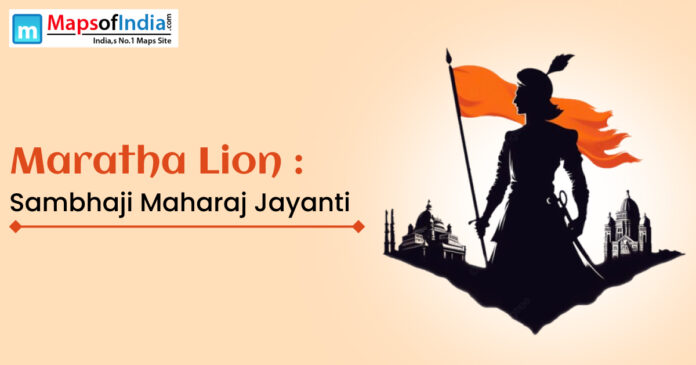Introduction: A Day to Honor a Hero
The birth anniversary of Sambhaji Maharaj, or Sambhaji Jayanti, is celebrated in Maharashtra and other parts of India with great veneration. This day, 14 May, honours the memory of one of India’s most courageous and intelligent monarchs. Sambhaji Maharaj was the eldest son of the legendary Chhatrapati Shivaji Maharaj, and he played a crucial role in protecting the Maratha Empire and upholding the ideals of Swarajya.
Shivaji Maharaj is well known and remembered for creating and laying the foundation of the Maratha Empire, while Sambhaji’s contribution in expanding and securing it from the Mughal Empire does not get much light and was frequently overlooked. Celebrating Sambhji Jayanti is a way of celebrating his sacrifices for the nation and paying tribute to him.
Early Life and Education of Sambhaji Maharaj
Born into Royalty
Sambhaji Maharaj was the son of Chhatrapati Shivaji Maharaj and Maharani Saibai. He was born on May 14, 1657, at Purandar Fort near Pune, Maharashtra. He was groomed to carry forward the Maratha legacy from a very young age and was unlike most royal heirs, not only trained in warfare but was deeply engrossed in literature, politics, and diplomacy.
A Scholar and Warrior
Sambhaji’s remarkable intellect was something that separated him from everyone. He was multilingual and knew languages including Sanskrit, Marathi, Hindi, Persian, and Portuguese. His literary contributions and knowledge of scriptures reflects his deep knowledge of cultures and philosophy. He penned the Sanskrit text Budhbhushan, highlighting his learned skills.
This extraordinary blend of intellect and martial skills makes him a mighty leader and, prepared him for challenges on and off the battlefield.
Becoming the Second Chhatrapati
A Time of Transition
Sambhaji Maharaj’s mother, Maharani Saibai, died during Sambhaji’s childhood, and his life was spoiled in the political rivalries in the royal family. He has faced internal jealousy and succession politics. However, after the death of Shivaji Maharaj, Sambhaji became the second Chhatrapati of the Maratha Empire at the age of 23 years.
There was a time in his reign when the Maratha Empire faced threats, especially from Mughal Emperor Aurangzeb, who was resolute to end the idea of Swarajya.
Rising to the Challenge
Sambhaji Maharaj faced incursions from everywhere, including the Mughals, the Siddis of Janjira, and the Portuguese. But Sambhaji Maharaj’s leadership was so profound that the Marathas defended against these attacks and even launched counter-offensives.
Confronting the Might of the Mughal Empire
Aurangzeb’s Southern Campaign
One of the longest wars in Indian history, which was followed for 27 years, held in 1681 when Aurangzeb himself led a military campaign into the Deccan to dismantle the Maratha power.
Sambhaji Maharaj was great at his defensive powers through his tactics, surprise raids, and deep understanding of terrain, which helped to delay the Mughal advance for years.
A Master of Asymmetric Warfare
Sambhaji Maharaj had his tactics by creating some chaos and confusion during the war by not only defending the Maratha Forts and bastions but also launching daring attacks into Mughal territories. He was good at gaining support from different masses and winning the trust of local chieftains, uniting everyone under the Maratha flag.
Under his leadership, the Marathas weakened the Mughal Empire irreparably by the costly war and resisted the Mughal dominance in the Deccan.
The Betrayal and Martyrdom of a Lion
Captured Through Treachery
In 1689, the Mughal forces procured Sambhaji Maharaj because of the internal betrayal. He was offered leniency if he converted to Islam and relinquished the Maratha cause, but Sambhaji refused outright. His rebellion enraged Aurangzeb, which resulted in the most brutal execution in the history of India.
Torture and Execution
Sambhaji was tortured for 40 straight days, but he remains firm on his decision and principles and completely refused to surrender his dharma. Eventually, on 11 March 1689,he was executed hideously. His eyes were gouged out, his tongue was cut, he was dismembered, even then he never arched before the tyranny.
A Martyr Remembered
Sambhaji Maharaj’s sacrifice became a war cry for the Marathas. His martyrdom kindled a spirit of resistance in Maratha power, leading to the decline of the Mughal Empire and the renewal of the Maratha power under other renowned leaders like Rajaram, Tarabhai, and later Peshwa Bajirao.
Patrimony of Sambhaji Maharaj
A Symbol of Courage and National Pride
The story of Sambhaji Maharaj was about standing firm in the face of hardship, more than of war and politics. His life reflects the importance of inflexible values, cultural pride, and scholarly brilliance. He put his culture and dharma beyond his comfort, and it will remain forever in the hearts of millions.
Unsung Hero of Indian History
Sambhaji Maharaj has contributed a lot to Indian history, even then he remained unsung and neglected by many historical narratives. However, in recent years, there has been a revitalization of interest in his life, which might be because of the cultural movements, documentaries, and academic research highlighting his heroism and sacrifices.
How Sambhaji Jayanti is Celebrated
Processions and Cultural Programs
On 14 May, the cities and towns across Maharashtra set up shobha yatras and processions, traditional music is played with sword displays and recreation of historical events. People all dress up in traditional attire, and there are echoes of slogans like “Jai Sambhaji Maharaj” and “Har Har Mahadev.”
Lectures and Historical Exhibitions
Cultural Programmes held in educational institutions, which include seminars, plays and exhibitions. Activities related to his literary work, readings from his historic texts and discussions on his strategies take place, to educate the younger generation about his contributions.
Tributes on Social Media
This is the age of digitalization. People share their artworks, poems, and documentaries dedicated to his memories with hashtags like #SambhajiJayanti and #VeerSambhaji
Conclusion: The Eternal Flame of Resistance
Sambhaji Jayanti is not just a date on calender but a festival and celebration for many. It is a day to celebrate his legacy and his contributions. It is a day to remember his life and strive to live up to the values he lived and died for.
Sambhaji Maharaj was more than just a king—he was a philosopher-warrior, a martyr, and a torchbearer of Swarajya. His legacy continues to inspire generations who believe in justice, freedom, and national pride.
Let the spirit of Sambhaji Maharaj live on—not just in statues and speeches, but in our actions and ideals.
Jai Bhavani, Jai Shivaji! Jai Sambhaji Maharaj!




